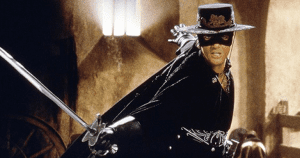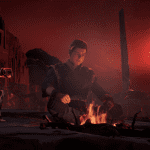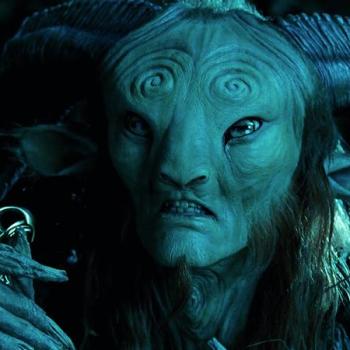
If there’s a single action movie I can say I was raised on—with the possible exception of The Blues Brothers and The Hunt for Red October—it would have to be Martin Campbell’s 1998 swashbucker The Mask of Zorro. Starring Antonio Banderas and Anthony Hopkins, this updated take on the legendary Mexican folk hero sits somewhere at the nexus of The Count of Monte Cristo and Robin Hood, chronicling the last years of one “Zorro” and the mentorship and rise of his young successor. Over a long weekend recently, I found this old gem on Amazon Prime and settled in to revisit it. (With a child on the way, I can confirm that stories of generational transition—of passing on a tradition from one era to the next—hit a great deal harder than they once did.)
Zorro traces the relationship between aristocrat Diego de la Vega—bent on avenging his wife’s murder and the kidnapping of his daughter—and orphaned commoner Alejandro Murrieta, determined to exact justice for his brother’s killing. Marshaled against them are Diego’s enemy Rafael Montero—a Spanish noble with dreams of national domination—and Alejandro’s nemesis Harrison Love, a sadistic army officer.
Under different circumstances, this would be strictly the stuff of B-movies. But there’s something about this film that feels genuinely timeless, more than twenty years since it first debuted in theaters. And I have a theory about what this might be: until recently, I didn’t realize how deeply the story was grounded in the principles of the “hero’s journey” so ably explored by Joseph Campbell in The Hero With a Thousand Faces.
Campbell’s book is known for its comprehensive analysis of mythological storytelling across cultures, and it famously influenced George Lucas’s development of the Star Wars saga. Lurking beneath the surface of Campbell’s text, however, is something much more provocative: a substantive argument for the universal metaphysical order underlying the experiences of ordinary life. On Campbell’s account, stories structured like traditional mythological narratives move us, across centuries and civilizations, because they tap into profound truths about the logic of reality. There is a correspondence, in short, between (1) the tales we pass on through time, (2) the ways in which we intuitively understand our lives, and (3) the mind-independent world we inhabit.
Over and over, the plot beats of Campbell’s “universal myth” play out onscreen. When Alejandro is at his lowest point, he is called to adventure by the enigmatic Diego. He refuses the call at first, preferring an alcoholic stupor to the hard work of training and growth. He undergoes a series of challenges—both trials with the blade and tests of assimilation into elite society—that lead him further and further into his understanding of the order he inhabits. And the film culminates with Campbell’s much-discussed “atonement with the father”—Diego bestows upon Alejandro his blessing to marry his daughter, sanctifying a union that will ultimately ensure the continuation of the idea of Zorro.
There is, in short, a kind of cosmic logic underlying what unfolds onscreen. And indeed, it is this kind of cosmic order that Diego directly affirms, remarking at one point that “[t]here is a saying, a very old saying: when the pupil is ready the master will appear.” The transcendent rational order of all things, in short, compels such a result.
But it seems to me that there’s an additional dimension of the film that isn’t readily reduced down to Campbell’s mythic framework—one that has its roots in the distinct particularity of a historical moment. In particular, elements of the tale echo the traditional medieval understanding of kingship explored by Ernst Kantorowicz in his seminal work The King’s Two Bodies: A Study in Medieval Political Theology.
At the heart of Kantorowicz’s project is the concept of the “two bodies” of the king—the physical person of the man holding the throne, and the metaphysical reality of the institution occupied by the physical person. While the king’s physical body might age and decay, the king’s eternal body—a body metaphysically instantiated within, and accountable to, the people of the realm he administers—persists forever. (As Kantorowicz takes pains to point out, this is a duality that draws on the logic of orthodox Christology: Jesus is at once both a singular historical human being, and a real presence embodied within the universal Church he inaugurated.)
The concept of Zorro that rests at the heart of the Zorro film is a somewhat modernized incarnation of the idea Kantorowicz traces. As the film unfolds, viewers come to see that Zorro seems to be less an individual than a principle, a figurehead who both exemplifies the “people” and simultaneously transcends them. Zorro is marked by an ideal (populism), an aesthetic (black hat, black cloak, black horse), and a symbol (a fiery “Z”) that stand apart and above any finite physical individual. And so it would seem that Zorro, just like the archetypal medieval king Kantorowicz describes, possesses “two bodies”—the physical and the ideal.
What to make of all this? It seems to me, in the end, that Zorro may in one sense be a traditional hero’s journey in the Joseph Campbell vein, but it draws its truly distinctive power from the synthesis of the particular with the universal—or, put in more theological terms, the intersection of the human and the divine. And that is a very fruitful thought indeed.












